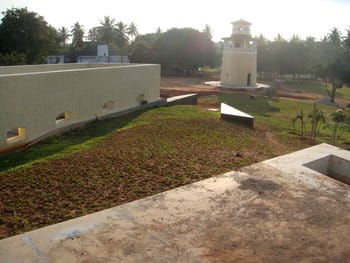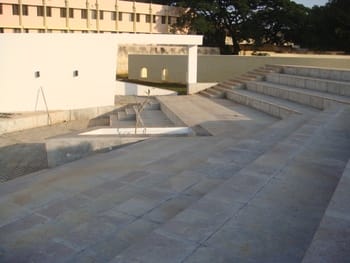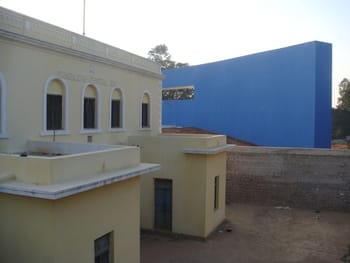The most awaited park of the Bruhat Bangalore Mahanagar Palike (BBMP), the Freedom Park, opened to the public in November 2008, even as a number of facilities inside are still not functional. This, over-20 acre park, built on the former Central Jail premises on Seshadri Road is mainly constructed for arranging rallies, dharnas and protests and, therefore, not affecting the flow of traffic on such occasions.

Garden area inside Freedom Park ( pic: Architects Mathew and Ghosh )
The Freedom Park, now a vital green lung space in fast-concretising Bengaluru, has a long history to it. The plans for the park were finalised as early as 2002. The project was conceived in 2004 and the work started only in 2006 with a cost of Rs.8 crores. The BBMP requested for an enhanced budget of Rs.8 crores for the project and, finally, Rs. 10.27 crores was sanctioned for the entire Freedom Park.
The engineering department of the BBMP is excited about the project and Engineer-in-Chief, A K Gopalaswamy, cannot stop raving about it. "It is a masterpiece in itself. No one imagined that the Central Jail could get this makeover while retaining its historical significance," he says. The barracks and the hospital blocks are being retained as heritage structures, he adds.
The central tower and the prison’s entrance block are the other structures that have found their way into the park. The park has been categorised under six broad areas: general, museum and exhibition, contemporary art, retail, performance spaces and water features. According to the BBMP engineers, some of the areas in the park will have entry fees, which will be used for its maintenance.

Amphitheatre ( pic: Architects Mathew and Ghosh )
Five acres of the park would be set aside for arranging rallies and protests, says the BBMP. "This space is on the lines of Hyde Park in London. The maintenance of this park will probably be outsourced," says Gopalaswamy. He explains that delays in awarding contracts have been a key reason for the slack in progress.
The design to convert a prison into a park was done by Soumitro Ghosh and Nisha Mathew Ghosh of Mathew & Ghosh Architects Pvt Limited, a husband and wife team. They were chosen after they won a nation-wide contest in 2003. The competition was initiated by the BBMP and the Bangalore Agenda Task Force. The couple had not worked with BBMP before, though they had carried out a lot of projects for the PWD.
Some of the key points in the park’s construction, according to the architect couple, were "using all sustainable resources, proposing a people’s court of eastern light and western reflection with an eccentric position of the central tower". They say BBMP’s good team spirit helped them a lot in creating this unique place.

Old Building of Central Jail. It has been preserved because of its historical significance ( pic: Architects Mathew and Ghosh )
The park has more to it than just the rally area; it has a joggers track (3,000 sq m), children’s play area (5,200 sq m), jail museum, information corridor gallery, book museum, children’s interactive museum in the old cells yard, tree museum and an outdoor exhibition park. The Freedom Wall stretch of the old jail will house a permanent multimedia art sculpture court, pathway junctions, designer souvenir shops, book shop, traditional craft stalls, 150-seater amphitheatre, 50-seater enclosed theatre space and an open plaza for gathering. There will be a water pool at main entrance and natural localised water percolation zones visible only in the rainy season.
All these amenities are yet to become operational, and when they do, Bengaluru will indeed have something special to look forward to.⊕
Wow. This one finally got done! Looks awesome. Can’t wait to get there and take a look!
It is great ! Finally the high walls which one has been seeing for years has come down !
This is a good breather for our city – in spite of all the trees felled right outside the campus. Lets hope this place gets much greener and makes up for all the trees that we’ve lost.
It’s really ironic that the authorities should call it Freedom Park, and cut down huge trees outside the campus. Also, the huge wall did look very ugly when we went to meet and plead (unsuccessfully) with the BBMP Empowered Committed not to fell the trees.